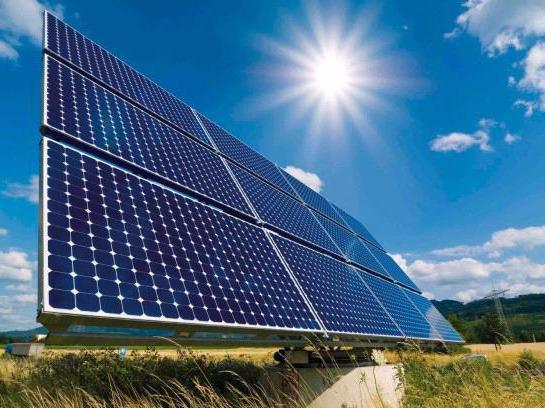






2. Pellets 8mm
3. 6-8 mm DIN+ Quality Pellets
4. We manufacture and sell fuel pellets from straw to European countries
5. Sell wood pellets
6. Wood pellet manufacturing
7. Sunflower Husk Pellets
8. Din Plus Wood Pellets
9. Export of sunflower husk pellets to the European market
10. Export of sunflower husk pellets to the European market
How Solar works?
Sat-18-2016
Solar panel electricity systems, also known as solar photovoltaics (PV), capture the sun's energy using photovoltaic cells. These cells don't need direct sunlight to work – they can still generate some electricity on a cloudy day. The cells convert the sunlight into electricity, which can be used to run household appliances and lighting.
PV cells are made from layers of semi-conducting material, usually silicon. When light shines on the cell it creates an electric field across the layers. The stronger the sunshine, the more electricity is produced. Groups of cells are mounted together in panels or modules that can either be mounted on your roof or on the ground.
The power of a PV cell is measured in kilowatts peak (kWp). That's the rate at which it generates energy at peak performance in full direct sunlight during the summer. PV cells come in a variety of shapes and sizes. Most PV systems are made up of panels that fit on top of an existing roof, but you can also fit solar tiles.
Solar tiles are designed to be used in place of ordinary roof tiles. A system made up of solar tiles will typically cost about twice as much as an equivalent panel system. Solar tile systems are not normally as cost-effective as panel systems, and are usually only considered where panels are not considered appropriate for aesthetic or planning reasons.
Solar system save carbon dioxide
A 4kWp system can generate around 3,800 kilowatt hours of electricity a year in the south of England – that's the same amount of electricity as it takes to turn the London Eye 50 times. It will save nearly two tonnes of carbon dioxide every year. A 4kWp system in Scotland can generate about 3,200 kilowatt hours of electricity a year – that’s the same amount of electricity as it takes to turn the Falkirk Wheel 2,100 times. It will save more than a tonne and a half of carbon dioxide every year.
The average domestic solar PV system is 4kWp and costs £5,000 - 8,000 (including VAT at 5 per cent).
Tariffs will also be subject to an adjustment for RPI (Retail Prices Index) so may change from those stated in this table.
A 4kWp system can generate around 3,400 kilowatt hours of electricity a year – roughly equivalent to a typical household's electricity needs. It will save over a tonnes and a half of carbon dioxide every year.
If your system is eligible for the NIROC (Northern Ireland Renewable Obligations Certificates), you could generate savings and receive payments of around £725 a year (based on a 4kWp solar PV system eligible for a generation tariff of 16.32p/kWh, using a ROC rate of 4.08p/kWh). You will get paid for both the electricity you generate and use, and what you don't use and export to the grid if you register before September 2015. When applying for NIROCs you will need to apply through Power NI if your system is below 50kW.
If you know your system size, you can get a tailored estimate of FIT payments for your system using our Solar Energy Calculator.
Costs can vary between installers and products, so we recommend getting quotes from at least three installers.
Solar PV is eligible for Feed-in Tariffs and you will earn a tariff for each kWh of electricity generated by your system. You will also receive another tariff for each kWh of electricity you export.
Little necessary maintenance for Solar PV
Solar PV needs little maintenance – you'll just need to keep the panels relatively clean and make sure trees don't begin to overshadow them. In the UK panels that are tilted at 15° or more have the additional benefit of being cleaned by rainfall to ensure optimal performance. Debris is more likely to accumulate if you have ground mounted panels.
Once fitted, your installer should leave written details of any maintenance checks that you should carry out from time to time to ensure everything is working properly. This should include details of the main inverter fault signals and key trouble-shooting guidance. Ideally your installer should demonstrate this to you at the point of handover. Keeping a close eye on your system and the amount of electricity it’s generating (alongside the weather conditions) will familiarise you with what to expect and alert you to when something might be wrong.
The panels should last 25 years or more, but the inverter is likely to need replacing some time during this period, at a current cost of about £800. Consult with your installer for exact maintenance requirements before you commit to installing a solar PV system.
Source: http://ukrfuel.com/news-solar-panels-122.html
Any copying and distributing withoutactive hyperlink is strictly prohibited!
Views: 2641
 Stobart biomass division is to make a deal
Stobart biomass division is to make a deal
Biomass Related News
- Cochran Ltd. and Scot Heat & Power Ltd. cooperate on bioenergy for industrial market
- New ways of making large, flexible solar panels more feasible are found
- Ukrainian Biofuel Portal assists in purchasing pellets manufactured in Ukraine
- 150-Year-Old Galapagos tortoise Dies at San Diego Zoo
- RPD and XOOM Energy Team Companies declare about its alliance
- Solar panel new technologies bring high efficiency
- The Valley (Pembrokeshire) Ltd is seeking full planning permission
- The future of biomass-based diesel
- Charcoal production methods
- Ikea starts selling solar panels through new ‘Solar Shops’
|
© Ukrainian Biofuel Suppliers 2008-2024 |
